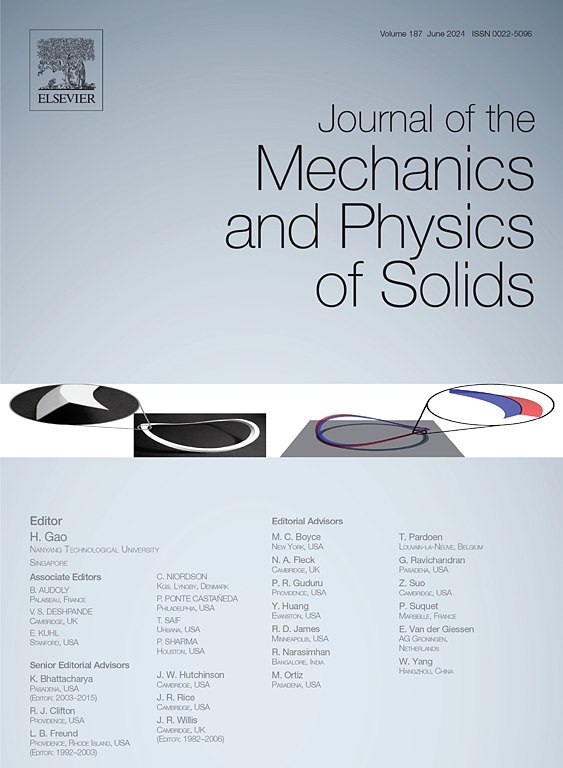Ultra-fast physics-based modeling of the elephant trunk
IF 5
2区 工程技术
Q2 MATERIALS SCIENCE, MULTIDISCIPLINARY
引用次数: 0
Abstract
With more than 90,000 muscle fascicles, the elephant trunk is a complex biological structure and the largest known muscular hydrostat. It achieves unprecedented control through intricately orchestrated contractions of a wide variety of muscle architectures. Fascinated by the elephant trunk’s unique performance, scientists of all disciplines are studying its anatomy, function, and mechanics, and use it as an inspiration for biomimetic soft robots. Yet, to date, there is no precise mapping between microstructural muscular activity and macrostructural trunk motion, and our understanding of the elephant trunk remains incomplete. Specifically, no model of the elephant trunk employs formal physics-based arguments that account for its complex muscular architecture, while preserving low computational cost to enable fast screening of its configuration space. Here we create a reduced-order model of the elephant trunk that can – within a fraction of a second – predict the trunk’s motion as a result of its muscular activity. To ensure reliable results in the finite deformation regime, we integrate first principles of continuum mechanics and the theory of morphoelasticity for fibrillar activation. We employ dimensional reduction to represent the trunk as an active slender structure, which results in closed-form expressions for its curvatures and extension as functions of muscle activation and anatomy. We create a high-resolution digital representation of the trunk from magnetic resonance images to quantify the effects of different muscle groups. We propose a general solution method for the inverse motion problem and apply it to extract the muscular activations in three representative trunk motions: picking a fruit; lifting a log; and lifting a log asymmetrically. For each task, we identify key features in the muscle activation profiles. Our results suggest that the elephant trunk either autonomously reorganizes muscle activation upon reaching the maximum contraction or chooses the inverse problem branches that avoid reaching the contraction constraints throughout the motion. Our study provides a complete quantitative characterization of the fundamental science behind elephant trunk biomechanics, with potential applications in the material science of flexible structures, the design of soft robots, and the creation of flexible prosthesis and assist devices.
超高速的基于物理的象鼻建模
大象的鼻子有超过9万个肌束,是一个复杂的生物结构,也是已知最大的肌肉静水器。它实现了前所未有的控制,通过复杂的各种肌肉结构的精心安排的收缩。被象鼻的独特表现所吸引,各个学科的科学家都在研究它的解剖、功能和力学,并将其作为仿生软机器人的灵感来源。然而,到目前为止,在微观肌肉活动和宏观结构躯干运动之间没有精确的映射,我们对象鼻的理解仍然不完整。具体来说,没有一个象鼻模型采用正式的基于物理的论证来解释其复杂的肌肉结构,同时保持较低的计算成本,以便快速筛选其构型空间。在这里,我们创建了一个象鼻的降阶模型,它可以在几分之一秒内预测象鼻肌肉活动的运动。为了确保在有限变形状态下得到可靠的结果,我们将连续介质力学的第一原理与纤维活化的形态弹性理论相结合。我们采用降维的方法将躯干表示为一个活跃的细长结构,这导致了其曲率和延伸作为肌肉激活和解剖功能的封闭形式表达式。我们从磁共振图像中创建了躯干的高分辨率数字表示,以量化不同肌肉群的影响。我们提出了一种反运动问题的通解方法,并将其应用于提取三个具有代表性的躯干运动中的肌肉激活:采摘水果;举起一根木头;不对称地提起对数。对于每个任务,我们确定了肌肉激活谱中的关键特征。我们的研究结果表明,象鼻要么在达到最大收缩时自主重组肌肉激活,要么在整个运动过程中选择避免达到收缩约束的逆问题分支。我们的研究为象鼻生物力学背后的基础科学提供了一个完整的定量表征,在柔性结构的材料科学、软机器人的设计以及柔性假肢和辅助装置的创造方面具有潜在的应用。
本文章由计算机程序翻译,如有差异,请以英文原文为准。
求助全文
约1分钟内获得全文
求助全文
来源期刊
CiteScore
9.80
自引率
9.40%
发文量
276
审稿时长
52 days
期刊介绍:
The aim of Journal of The Mechanics and Physics of Solids is to publish research of the highest quality and of lasting significance on the mechanics of solids. The scope is broad, from fundamental concepts in mechanics to the analysis of novel phenomena and applications. Solids are interpreted broadly to include both hard and soft materials as well as natural and synthetic structures. The approach can be theoretical, experimental or computational.This research activity sits within engineering science and the allied areas of applied mathematics, materials science, bio-mechanics, applied physics, and geophysics.
The Journal was founded in 1952 by Rodney Hill, who was its Editor-in-Chief until 1968. The topics of interest to the Journal evolve with developments in the subject but its basic ethos remains the same: to publish research of the highest quality relating to the mechanics of solids. Thus, emphasis is placed on the development of fundamental concepts of mechanics and novel applications of these concepts based on theoretical, experimental or computational approaches, drawing upon the various branches of engineering science and the allied areas within applied mathematics, materials science, structural engineering, applied physics, and geophysics.
The main purpose of the Journal is to foster scientific understanding of the processes of deformation and mechanical failure of all solid materials, both technological and natural, and the connections between these processes and their underlying physical mechanisms. In this sense, the content of the Journal should reflect the current state of the discipline in analysis, experimental observation, and numerical simulation. In the interest of achieving this goal, authors are encouraged to consider the significance of their contributions for the field of mechanics and the implications of their results, in addition to describing the details of their work.

 求助内容:
求助内容: 应助结果提醒方式:
应助结果提醒方式:


